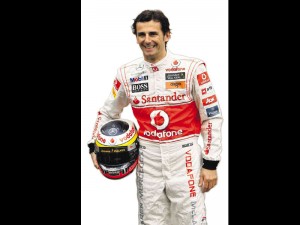
We’re definitely a lot more competitive. We’re in better shape. In terms of the race pace, we’re fighting for pole position all the way. We have what you call super-soft tires, so if you make a mistake in your fastest lap, you have no choice but go back and change them. So we have to be careful about every single move we make.
What’s your take on the Singapore racetrack right before us?
You can’t make mistakes here! Formula One here in Singapore is a night race—it’s spectacular for the spectators. For us drivers, it’s one hell of a track. We spend so many laps in the simulator test back home to train and practice. We jokingly call it “The Stimulator.” (Laughs.) We have to drive on the track at a maximum level, more than anywhere else in the world. We must have done more than 250 laps in the simulator to be able to master it.
In addition, you have to adjust to the city’s heat and humidity.
Humidity and heat are the worst things. The only secret is learning how to drink water—before, during and after the race. There are one and a half liters of water inside the car for us to drink. When racing in Monaco, for example, it’s hard. The circuit is so complex—there are no straight paths, and obviously you can’t pause to drink in a corner, so your concentration
Which of the Formula One races around the world do you recommend for a first-time spectator?
Australia is a must, it’s the first race of the season and everyone gauges who’s going to turn out strong. Montreal is amazing, Singapore for sure, and Monaco—you have to watch the race at least once. Then, Spain—my home country, of course, for the great atmosphere.
We heard Tokyo also holds a special place in your heart.
I’ve raced competitively in Tokyo for three years, and those were the best years of my career. I had a great time. I became a man there. I learned everything. Without Tokyo, I wouldn’t be here. Every year, for a few days, whenever we go there for F1, I spend a few days going around the city.
This season sees the race going to India for the first time.
And it comes after Tokyo! So many unknowns still about this race since no one has driven there. It makes me excited and nervous at the same time.
You read about racers touring the world obviously for the sport, but also doing some heavy partying in between. Is this an accurate or unfair picture of your lifestyle?
What’s the hardest part then about moving around the globe for competitive sports?
Wherever we go, we move according to European time. Our sleeping patterns are based on what time it is back home. You really feel it here in Singapore—we’re obviously on the other side of the world. In our hotel rooms, curtains and windows are completely sealed so no light comes in. For our meals, we go to a special room in the hotel where only we eat. We live completely out of sync with everyone else. That’s not exactly easy.
What do you like doing during your free time?
Three things I focus on during breaks: cycling, trains and my kids.
We heard you’re also into building model planes.
Well, now that I have kids, the model planes just end up crashing and getting destroyed by them. (Laughs.)
What do you think of racecar drivers whose hobby is to rally cars and motorbikes?
What’s one piece of advice you wish you could tell every competitive racecar driver?
There’s no point in racing with a calculator.
Almost 90 Grands Prix later, do you still feel the buzz—the energy—every time you step inside the circuit?
I still feel like it’s my first Grand Prix each time I come for a race. I always look forward to racing—the energy, the adrenaline. Right now I’m a reserve driver, but for sure I will race competitively in the next two years. After which, I will retire. It’s great to be a reserve, but I was born to drive.
Special thanks to Diageo and Johnnie Walker Philippines.